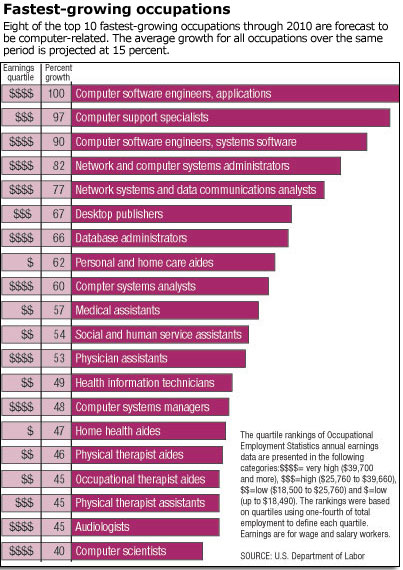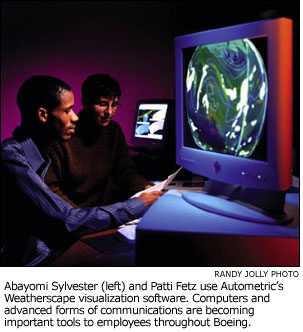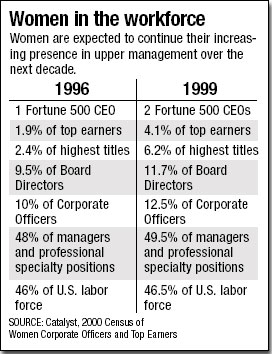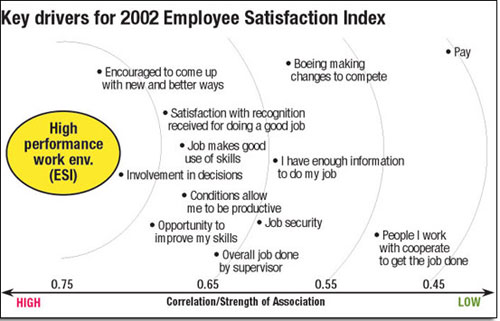Building the 21st
century WORK
FORCE
Boeing offers a myriad of training,
educational and career-broadening opportunities to help employees stay
employable over a lifetime
BY PAUL PROCTOR

When was the last time you were in a bank?" It's a question
that frequently comes up when Laurette Koellner, Boeing chief People and
Administration officer, Office of the Chairman, addresses employee meetings
and leadership training sessions.
The point: how the introduction of new technology and processes — in
this case the automatic teller machine and Internet banking — can
rapidly revolutionize even the most established, regimented industry.
According to Koellner, many people can't remember when they last
conducted a banking transaction with a human teller.
 Indeed,
the move to ATM-based banking is a microcosmic example of the fast-moving,
seismic changes transforming the business world today. Major social, economic,
technological and demographic forces are touching all of us — at work,
at home and during our leisure hours. Indeed,
the move to ATM-based banking is a microcosmic example of the fast-moving,
seismic changes transforming the business world today. Major social, economic,
technological and demographic forces are touching all of us — at work,
at home and during our leisure hours.
In particular, these changes are affecting the way we perform our jobs
and how we will work in the future at Boeing.
Exciting work ahead
So what might the workplace — and workforce — of the future look
like? We don't know, exactly, but it's likely to be very different,
said Chairman and CEO Phil Condit. He believes Boeing will remain a good
place to work. He's predicted the aerospace industry will be every
bit as exciting in the 21st Century as it was in the 20th.
Advances in information technology are adding a major new dimension to
the workplace, Condit said. For instance, complex products now are pre-assembled
digitally, and shop floor work instructions come directly from a computer.
Ubiquitous, highly accurate voice-recognition systems could mean that
we no longer have to type and are less dependent on our desktop and laptop
computers. Many people won't have the clerical chore of inputting
data any more, because tomorrow's integrated systems all will talk
to each other.
These and other advances will reshape jobs at almost all levels of Boeing,
Condit said, although how and to what extent is unclear. For instance,
aided by a steady flow of accurate electronic information from Boeing
News Now and other sources, managers will be free to do more coaching
and spend less time passing along routine company-wide communications
to their direct reports.
Workers at all levels will be teaming and collaborating more, across
departments, across business units and likely even among different continents.
Better electronic tools will be introduced to help the collaboration process,
so employees can see what all other members of their team are working
on in real time, whether it's an article for Boeing Frontiers
or a new airplane, Condit said.
Not your parents' workforce
To meet changing workforce needs, Boeing is focusing on better preparing
its existing employees with the skills, experience and knowledge they
need to participate — and prosper — in the 21st century work environment.
"Skills are a competitive advantage," said Joel Cutcher-Gershenfeld,
senior research scientist at the Massachusetts Institute of Technology's
Sloan School of Management and executive director of MIT's Lean
Aerospace Initiative. "The old social contract was 'if you
come to work regularly and follow the rules, we'll continue to employ
you'" in the same job. "That contract has been shattered
over the past 10 years" by global competition and other factors,
he said. "Now companies are saying 'we can't guarantee
to continue your job, but if you continue to build your skills, we can
continue to employ you,'" he said.
Although the U.S. aerospace industry has far to go in establishing the
mechanisms to instill this culture, "there's a clear advantage
when people learn skills that will keep them employable over a lifetime,
and for an employer to have a workforce that is current and capable,"
Cutcher-Gershenfeld said.
Boeing is off to a strong start. "The company's 'contract'
with the employee is no longer lifelong employment, but rather lifelong
employability," said Mike Sears, chief financial officer, Office
of the Chairman.
Simply stated, lifelong employability is a strategy whereby the company
and individual employees jointly plan new training, education and work
assignments to upgrade the employee's skill and experience levels
continuously.
Although Boeing provides the tools, means and opportunities for employees,
it is the individual's responsibility to take action, Condit said.
 Successfully
applied, the lifetime employability strategy yields Boeing a more capable,
experienced, adaptable and well-rounded worker. But more importantly,
the practice is a major plus for the individual employee — increasing
his or her stature in the current job while boosting job satisfaction.
It also enhances an employee's eligibility for promotions and opportunity
for moves to more desirable jobs within the company. This is so even if
the employee remains on a single career path, such as that of an engineer
or scientist. Successfully
applied, the lifetime employability strategy yields Boeing a more capable,
experienced, adaptable and well-rounded worker. But more importantly,
the practice is a major plus for the individual employee — increasing
his or her stature in the current job while boosting job satisfaction.
It also enhances an employee's eligibility for promotions and opportunity
for moves to more desirable jobs within the company. This is so even if
the employee remains on a single career path, such as that of an engineer
or scientist.
Indeed, Boeing today is such a broad-based enterprise that its employees
"can have multiple careers over their work life without ever having
to leave the company," Koellner said. "You can work on commercial
airplanes, military products, space products, advanced technology or in
finance." Employees can work in virtually any region of the United
States and — increasingly — internationally, she said.
While Boeing seeks to retain its workers, the lifelong employability
concept also helps provide employees with transferable skills, increasing
their "marketability" for other jobs inside — and even
outside — the company should an economic downturn occur.
Change for the good
Job forecasts make a compelling case for employees continually upgrading
their job skills. As Boeing transitions from an exclusively product-focused
hardware supplier to an agile, balanced aerospace company with integrated
systems capabilities, it is estimated to create a gross total of 200,000
'new' equivalent jobs over the next 10 years, to be filled from both internal
and external talent sources. Overall, the U.S. economy is forecast to
add approximately 20 million jobs in the decade ending in 2010, according
to the Bureau of Labor Statistics. And that doesn't count the millions
of new jobs projected in other countries over the same time period.
However, manufacturing employment is projected to increase only three
percent between 2000 and 2010, although from a larger base, according
to BLS figures.
More than half of the job growth over this same period will be in professional
and service occupations, predicts the authoritative Workplace Forecast
for 2002-2003, published by the Society of Human Resource Managers, which
uses BLS statistics.
Although low-paying service jobs will represent the lion's share
of the total, demand will be greatest for the highly paid professional,
or "knowledge" occupations, SHRM said. Eight of the 10 fastest-growing
occupations are anticipated to be in information technology. All but two
of the 50 highest-paying jobs will require a college degree.
The growing skills shortage is best illustrated by a Hudson Institute
survey, "Workforce 2020: Work and Workers in the 21st Century."
It indicates that by 2020, 60 percent of jobs will require skills that
only 20 percent of today's population now has.
Learning for life
One of the best ways employees can improve their knowledge is by taking
advantage of the company's Learning Together tuition reimbursement program,
Condit said. Learning Together pays 100 percent of the cost of coursework
on any subject from regionally, nationally or selected professionally
accredited schools or universities, whether it relates to the employee's
job or not. To qualify for the reimbursement, courses must be attended
on personal time and result in college credits or Continuing Education
Units.
The company values learning so highly that it spent $87 million on tuition,
books and certain required expenses for the Learning Together program
in 2001, according to Koellner. It is an investment the company is continuing
even in a year of reduced revenues for the company. "It was never
suggested by anyone [on the Board of Directors or senior Boeing management]
that we cut this investment," she said. Through Learning Together,
"This company has the most competitive tuition reimbursement policy
that I've ever seen, anywhere," she said.
Last year, 30,000 Boeing employees participated in the Learning Together
program. They earned 1,900 degrees.
A key aim of the Learning Together program is to promote the practice
of "lifelong learning," also called "continuous learning,"
by Boeing workers. Employees used to learn basic skills in school that
served them throughout their career, Condit said. Today, it's important
to be learning continuously because major changes are taking place inside
the course of a career, he said. Continuous learning adds knowledge and
expands individuals' understanding and their capability throughout
their life, he said. It also engages them, stimulates new thinking, and
helps bring diversity of thought to the workplace.
 "A
willingness to evolve and continue to learn is more than critical; it
is crucial," Koellner said. "In the coming years, the application
and adoption of technology will grow exponentially," she said. "A
willingness to evolve and continue to learn is more than critical; it
is crucial," Koellner said. "In the coming years, the application
and adoption of technology will grow exponentially," she said.
Other Boeing educational opportunities include the Boeing Leadership
Center, located outside St. Louis. It offers courses covering the management
spectrum, from beginning managers to executives at the most senior level.
The Leadership Center's annual budget is approximately $30 million,
Koellner said.
Training for tomorrow
Boeing offers thousands of training courses ranging from industrial skills
and certification programs to computing and business awareness. This training
is delivered in classrooms; at the desktop as self-paced instruction that
can be Web-based, computer-based or paper-based; or through televised
classes on the Boeing Education Network. Curricula offerings and course
schedules can be viewed at: http://lead.web.boeing.com (Employees also
may check with their regional Training organization coordinator for course
offerings.)
Overall, Boeing has approximately 1,000 training professionals and is
estimated to have an annual training budget exceeding $300 million. In
February, Minneapolis-based Training Magazine ranked the company
15th in its Top 100 companies for employee training in the U.S. The survey
evaluated more than 1,000 companies whose core business is not training.
Boeing makes new opportunities visible companywide through the Boeing
Enterprise Staffing System, a Web-based hiring support system developed
and administered by the Shared Services People team. Also known as Jobs@Boeing,
the system processed more than 92,000 internal and external resumes during
April, its first full month of operation. That's a pace that would
result in more than 1.1 million resumes this year.
The highly automated BESS process streamlines the hiring cycle, making
it as easy as possible for Boeing to expediently hire top quality internal
and external candidates. One of its most popular features is its ability
to establish job-preference profiles that automatically notify job seekers
of matching employment openings.
Each day, more than 17,000 people look for opportunities at Boeing, both
internally and externally, and BESS sends more than 1,700 e-mails alerting
individuals to Boeing jobs they might be interested in.
Idea incubator
The Chairman's Innovation Initiative also offers an opportunity for employees
to expand their horizons under a unique program sponsored by Phil Condit.
Launched two years ago, this program is designed to foster an entrepreneurial
spirit within the company by creating and supporting new business activities
based on ideas from employees. Essentially, CII provides an opportunity
for employees to generate, develop and implement new businesses.
Managed by Boeing Ventures, the program seeks to unleash the innovative
talent of employees. The ultimate goal is creating new "spin-off"
ventures and "spin-ins" back into Boeing business units.
CII provides employees with the tools and support to help them take their
ideas for a new business from concept to reality. Innovators identify
a market need, build a team, proceed through several iterations to develop
a business concept and a plan to launch a business to satisfy that unmet
need. They develop the idea, build on it and eventually become a part
of it, as plans that are accepted and continue through the process are
financed and supported with the ultimate goal of creating a new business.
Throughout the process, CII surrounds innovators with a support infrastructure
to help them attain their goals. As an idea moves from concept to business
plan, CII offers expert advice, training, networking events, educational
seminars, financial support and other key resources. The support network
also includes mentors — business generalists who act as coaches on
strategy, finance and marketing issues.
Boeing also provides innovators with office space to incubate their ideas,
as well as access to subject matter and functional experts. CII has Innovation
Resource Centers that offer help for innovators developing business concepts.
 "Business-building,
by definition, is a synthesis of multiple skills — from accounting
to marketing, from strategy to finance," said Boeing Ventures Vice
President Anil Shrikhande. "As they proceed through the review phases
of the CII program, these innovators are continually learning new skills
and developing business acumen as they wrestle with the rough-and-tumble
of market dynamics." "Business-building,
by definition, is a synthesis of multiple skills — from accounting
to marketing, from strategy to finance," said Boeing Ventures Vice
President Anil Shrikhande. "As they proceed through the review phases
of the CII program, these innovators are continually learning new skills
and developing business acumen as they wrestle with the rough-and-tumble
of market dynamics."
Right moves
Lateral moves, too, offer great opportunities for employees to build
and add to their toolkit of skills and experience, according to Koellner.
Indeed, these can be "some of the best opportunities within a company,"
she said.
"When an employee is offered a lateral move, that's somebody
saying to them: 'We have enough confidence in you that we believe
that you can perform in an entirely different role that we haven't
seen you perform in before,'" Koellner said.
Once people see you operate and demonstrate skills in more than one role,
you by definition become more employable, as they are able to think of
you for other roles as well, she said.
Koellner can testify firsthand to the value of lateral moves. She left
a Boeing job in Florida to take a new job which also required uprooting
and relocating her family. Although to many it appeared she moved to a
job with a narrow range of responsibilities, it turned out "to be
a jumping off point for a whole new set of future moves, many of which
were lateral and provided experience and opportunities that were invaluable,"
she said.
International options
Within the changing global landscape, current Boeing employees can benefit
by working overseas and acquiring valuable experience, said Tom Pickering,
senior vice president of International Relations. In turn, Boeing benefits
from international workers who bring their diverse perspectives and ideas
to the company.
Pickering is working with Michael Valliere, vice president Compensation,
Benefits and Succession Planning, and his team at the World Headquarters
People organization, to establish an international job-exchange program
for both Boeing executives and non-executives. While there will be limited
numbers of such opportunities, in such a program, employees with similar
job functions would trade locations for a definite time, helping each
better understand global business — as well as their roles within
Boeing's worldwide enterprise.
Today and into the future, Pickering said, it's imperative that
employees develop the in-depth global business knowledge and cultural
sensitivities that lead to profitable working relationships in countries
around the world.
"For our managers and executives, as we increasingly look at our
manufacturing and sales opportunities as having a worldwide scope, they
will [need to] understand how to do business in a non-American environment,
where the approaches of doing business are very different," Pickering
said.
Higher education partnership
Boeing also is taking a hard look at how it can best attract, develop
and retain the generation of workers that will be entering the workforce
over the next two decades, and the skills and tools they will be needing.
 One
avenue is the company's continuing support of education. One
avenue is the company's continuing support of education.
Approximately 40 percent of The Boeing Company's total philanthropy
is in the area of education, including more than $8 million each year
in charitable investments to institutions of higher education. Boeing
focuses these investments toward colleges and universities with a goal
of developing intellectual talent and promoting academic achievement.
This relationship fosters education, training and learning opportunities
for the current and future work force. It also helps provide faculty fellowships,
student internships and scholarships.
All told, Boeing donates to more than 200 schools and matches employee
giving to a total of more than 800. It supplements this with Boeing volunteers
on campus, along with technology, equipment and intellectual-property
donations.
But, the volume of aerospace degrees U.S. colleges and universities award
is on the decline. In 1991, they had awarded almost 4,100 undergraduate
and graduate engineering degrees in aerospace. By 2000, that figure had
decreased to only 2,175, MIT's Cutcher-Gershenfeld said.
To combat this trend, Boeing is starting earlier in its quest to interest
young people in math and sciences, Condit said. "Decisions get made
relatively early. ... We've got to be in the grammar schools
talking about the excitement of engineering, about the exciting things
that we do," Condit said. "And we've got to be using
the things kids look at every day. Whether it's a video game or
a toy, there's a lot of engineering in there."
Although the competition for talented recruits likely will intensify
in the future, currently Boeing seems to be holding its own. A June poll
of more than 6,000 undergraduate engineering and science students identified
Boeing as the No. 1 company for which to work, an increase from No. 5
last year. The Universum Undergraduate Survey also showed highly sought-after
information-technology students ranked the company among the top 25 companies
for whom they'd like to work.
Another Boeing new-hire thrust is "hiring for attitude."
Adopted from a pioneering program at Southwest Airlines, this hiring strategy
takes the approach that if you hire people with the right attitude, they
can do just about anything, said Linda Sawin, manager, Shared Services
Group Assessment Services.
In this process, five to six structured interview questions, focusing
on desired personality attributes, are developed in consultation with
top executives of the hiring organization. Results allow an apples-to-apples
comparison of candidates interviewed through this process, Sawin said.
The program has top-level support at Boeing. Initially used in the hiring
process for the Air Traffic Management business unit and Boeing World
Headquarters in Chicago, the strategy "is really paying off,"
Koellner said. In the future, "we intend to hire as much for attitude
as we do for capability," Condit said.
Future Boeing employees will have to be flexible and adaptable. They
will face a business environment that is constantly changing and more
ambiguous, said Cheryl Park, director of Organizational Development for
Boeing World Headquarters. Leadership skills are going to become even
more critical, and leaders will need to develop and follow a concrete
vision in the midst of this ambiguity. These leaders also will have to
build good communications skills and have the ability to inspire trust
throughout dispersed teams.
A significant part of tomorrow's job at Boeing, said Park, will
involve the ability to distinguish meaningful information from reams of
data — and having the wisdom, experience, intuition and guts to do
so.
Ch-ch-ch-changes
No one can predict exactly how Boeing jobs and the workplace will change
over the next two decades. But if there's one thing certain in life,
it's change. As Koellner points out: "Just look at how much
our company has changed in the past five years. There's no reason
to think that it won't change that much in the next five years."
paul.c.proctor@boeing.com
|